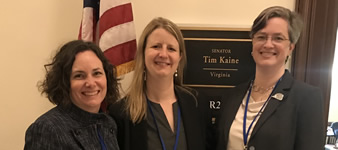
(L-R) Stefanie Warlick, Andrea Adams, KT Vaughan
Andrea Adams is the Interim Associate Dean in Libraries at James Madison University. She is responsible for leading online learning, faculty development, media production services, makerspaces, and classroom technologies in the libraries. Andrea has been in the educational field for over 20 years, including both K-12 and higher education. She received her MS.Ed in Educational Technology at James Madison University and a B.S. in Technology Education at Virginia Polytechnic Institute and State University.
With her diverse experiences in the health and life sciences, teaching and research, facilities operations, community outreach, and management, KT Vaughan brings an optimistic and inclusive perspective to library leadership. After seven years at James Madison University, including as the director of the science library and as Associate Dean, KT will join the Washington & Lee Library as Higginbotham University Librarian on June 1, 2020. Asking questions about – and driving change in – the future of libraries is a central theme of KT’s career. She is currently focused on building inclusive and equitable library environments for people with disabilities, scholarly and digital communication in resource-constrained contexts, and the career advancement and professionalism of library staff and faculty. KT holds the MSLS from UNC-Chapel Hill (2001) and an EdD from Arizona State University (2019). Her dissertation, “Building an Inclusive Library through Staff Accessibility Training” is available via the ASU and JMU institutional repositories.
Stefanie Warlick serves as an Interim Associate Dean of Libraries at James Madison University (JMU). A role she has held since July 2018. Stefanie previously held the position of Director of Public Services at JMU. Stefanie received a Master of Science in Library Science from the University of North Carolina at Chapel Hill in 2006.
In the spring of 2018 the JMU Libraries started an eighteen-month period of great change, including the dean’s resignation and an associate dean’s retirement. A newer Associate Dean and two Interim Associate Deans, working with an interim administrator with no library experience, lead and managed the organization during this period. This included helping the organization process the previous dean’s departure, maintaining our high service quality and strong relationships on campus, and preparing for the selection and arrival of the new dean.
The interim administrator had a clear mandate to “press pause” on new programs and services. This was to avoid creating conflicts with any vision or changes that a new dean would want to put into place. However, no organization can truly pause its development for a significant amount of time. Over this 18-month period the Libraries changed its organizational name, released a completely rebuilt website, hired 20 new staff and faculty including a new dean (~14% of the total staff), developed needed foundational policy and procedure documents, and prepared for substantive progress in areas such as digital scholarship and scholarly communication.
The ADs addressed the tension between maintaining and innovating services by focusing on modeling transparent and collaborative leadership. This started with the development and sharing of six strategic priorities on which the ADs would focus during the interim period. These six priorities provided a framework for the administration’s work, as well as for communicating out what was on pause vs. what was moving forward during the period. For example, work in one priority, “Continue to develop a shared understanding of roles and expectations particularly in the area of decision-making,” included improving equity in making resource allocation decisions for space, positions, and finances. Second, the ADs dramatically increased the quantity and variety of communication that they shared with the organization. This was to counter concerns about the organizational culture, which was tending towards untrusting and anti-inclusive, and to better recognize individual and team accomplishments. Third, they leveraged a collaborative leadership model to accomplish this sometimes difficult and political work in the most transparent, equitable,and sustainable way possible.
This poster will present a brief visual of the JMU Libraries case, followed by example activities and programs tied to each of the six priority areas. It will conclude with thoughts about collaborative and transparent leadership as a means of surviving and thriving both in the now and in the future.